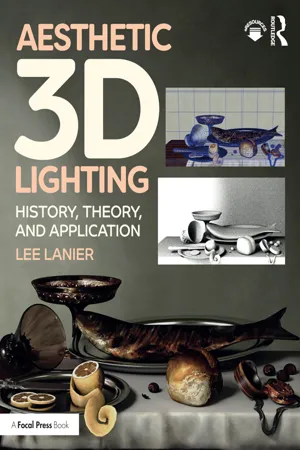
- 224 pages
- English
- ePUB (mobile friendly)
- Available on iOS & Android
About this book
Aesthetic 3D Lighting: History, Theory, and Application delves into the history, the theory, and the practical and aesthetic application of lighting in the fine arts and 3D animation.
In this book, animation industry veteran and lighting expert Lee Lanier examines the importance of lighting and its ability to communicate information to the viewer. Lee examines the history of lighting as applied to the fine arts, film, photography, and 3D animation. He discusses the use of light color, light location and direction, and light shadow types to recreate specific locations and to generate moods. He includes guides for successful lighting in 3D animation. Software-agnostic examples lead you through useful 3D lighting set-ups. Chapter-long case studies step you through more complex 3D lighting projects in Autodesk Maya.
An accompanying eResource (www.routledge.com/9781138737570) features 3D model files, scene files, and texture bitmaps, allowing you to practice the discussed techniques in Autodesk Maya and many other 3D programs.
The lighting techniques covered in this book include:
- History of lighting as used in the fine arts
- The scientific mechanisms of light
- Light types and light application in 3D programs
- Light qualities including shadows variations
- Basic and advanced 3D lighting approaches
- 1-, 2-, 3-point, naturalistic, and stylistic lighting techniques
- Replication of real-world lighting scenarios and locations
- Overview of advanced 3D lighting and rendering systems
Frequently asked questions
- Essential is ideal for learners and professionals who enjoy exploring a wide range of subjects. Access the Essential Library with 800,000+ trusted titles and best-sellers across business, personal growth, and the humanities. Includes unlimited reading time and Standard Read Aloud voice.
- Complete: Perfect for advanced learners and researchers needing full, unrestricted access. Unlock 1.4M+ books across hundreds of subjects, including academic and specialized titles. The Complete Plan also includes advanced features like Premium Read Aloud and Research Assistant.
Please note we cannot support devices running on iOS 13 and Android 7 or earlier. Learn more about using the app.
Information

Chapter 1: The Importance of Light and Lighting
Photo copyright Rungaroon Taweeapiradeemunkohg / 123RF Stock Photo
Light and Lighting
Information Communicated by Light
Time of Day

Light Sources and Location
Light Quality | Light Source and Possible Locations |
|---|---|
Strong, overhead light arriving from a single source creating a single distinct shadow (left side of Figure 1.2). | Sun, most likely outdoors. |
Strong, overhead light arriving from multiple sources and creating overlapping shadows or a single soft shadow (right side of Figure 1.2). | Banks of artificial lights, such as overhead fluorescent lights in an office or groups of flood lights in a stadium. |
Flickering light with red, orange, and yellow color and soft undulating shadows. | Fire light. Based on the intensity of the light and its relative motion, you can extrapolate how the fire is used (e.g. bonfire, fireplace fire, torch, candle flame, match flame, and so on). |
A “wall” of light arriving from one location and traveling in one direction. | Light from a television screen or monitor, sun light traveling indoors through a window, or light reflected off a large surface, such as a floor. |

Mood

SIDEBAR
Points-of-view
SIDEBAR
Light Shadowing
Table of contents
- Cover
- Half Title
- Title Page
- Copyright Page
- Table of Contents
- Introduction
- Chapter 1: The Importance of Light and Lighting
- Chapter 2: The History of Lighting in the Arts
- Chapter 3: Lighting in 3D
- Chapter 4: Emulating Specific Light Sources
- Chapter 5: Working with PBR Systems
- Chapter 6: Reproducing Locations and Lighting Characters
- Chapter 7: Designing Stylistic Lighting
- Case Study 1: Copying a Renaissance Still Life
- Case Study 2: Lighting a Complex Night Interior
- Case Study 3: Lighting an Animated Animal Character
- Epilogue: The Future of 3D Lighting
- Appendix: Visual Lighting Glossary
- Appendix: Common Question Index
- Index